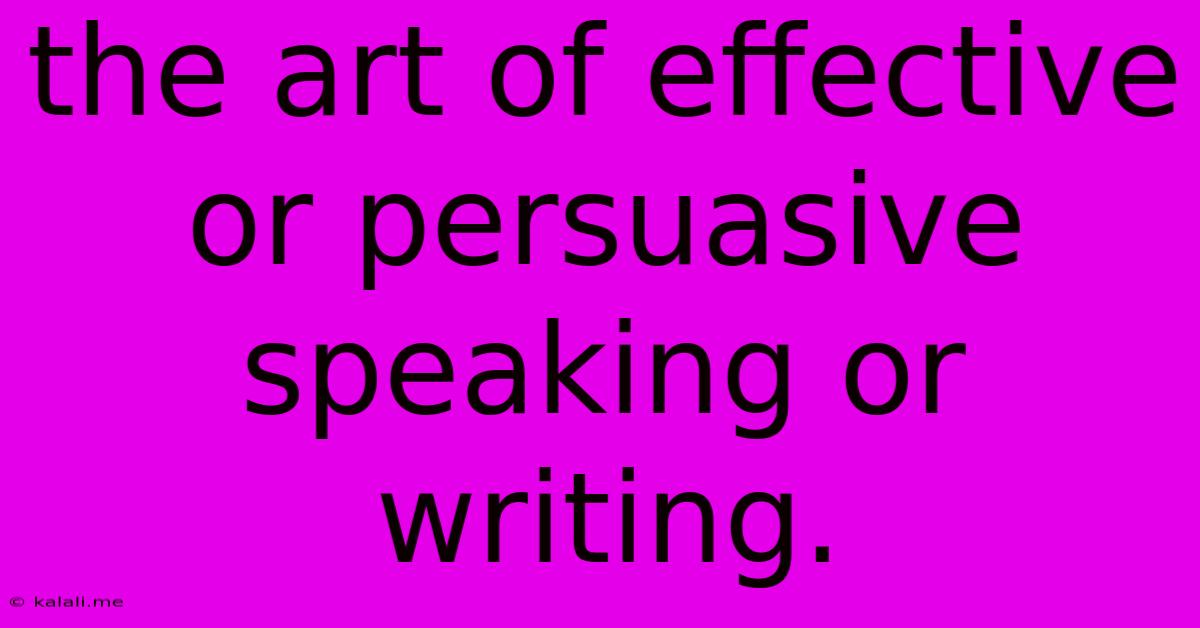The Art Of Effective Or Persuasive Speaking Or Writing.
Kalali
Jun 14, 2025 · 3 min read

Table of Contents
The Art of Persuasion: Mastering Effective Speaking and Writing
Meta Description: Learn the secrets to persuasive communication! This guide explores the art of effective speaking and writing, covering techniques to influence audiences and achieve your goals. Master rhetoric, storytelling, and emotional intelligence to become a truly persuasive communicator.
Persuasion is a powerful tool, vital for success in any field – from business negotiations to political speeches, from marketing campaigns to everyday conversations. Whether you’re crafting a compelling sales pitch or delivering a moving presentation, the ability to persuade hinges on a deep understanding of your audience and the masterful application of certain techniques. This article explores the art of effective speaking and writing, providing insights into how to influence your audience and achieve your desired outcome.
Understanding Your Audience: The Foundation of Persuasion
Before crafting your message, thorough audience analysis is crucial. Consider their:
- Demographics: Age, gender, socioeconomic status, education level, etc.
- Psychographics: Values, beliefs, attitudes, interests, lifestyle.
- Needs and Wants: What problems are they facing? What aspirations do they hold?
- Existing Knowledge: What do they already know about the topic?
Tailoring your language, tone, and arguments to resonate with your specific audience is paramount to successful persuasion. A persuasive message speaks directly to their needs, addressing their concerns and offering solutions that align with their values.
The Power of Storytelling: Connecting on an Emotional Level
Humans are inherently emotional creatures. While logic and reason play a role in persuasion, tapping into emotions is often the key to unlocking true influence. Storytelling is a powerful technique to achieve this. Effective stories:
- Evoke Empathy: Place your audience in the shoes of your characters, allowing them to feel their experiences.
- Create Memorable Moments: Engaging narratives stick in the minds of your audience long after the presentation is over.
- Illustrate Your Points: Stories provide concrete examples, making abstract concepts more relatable and easier to understand.
- Build Trust and Credibility: Sharing personal anecdotes can humanize your message and make you more approachable.
Mastering Rhetoric: The Art of Argumentation
Rhetoric, the art of persuasive speaking or writing, employs various techniques to strengthen your message. These include:
- Ethos (Credibility): Establish your expertise and trustworthiness through evidence, citations, and a confident delivery.
- Pathos (Emotion): Appeal to your audience's feelings by using vivid language, evocative imagery, and compelling storytelling.
- Logos (Logic): Use reason and evidence to support your claims, presenting a clear and logical argument.
Employing these rhetorical appeals strategically ensures a balanced and convincing message. Avoid relying solely on one appeal; a combination is often the most effective approach.
Crafting Compelling Content: Writing for Persuasion
Effective persuasive writing requires careful consideration of structure and style:
- Clear and Concise Language: Avoid jargon and overly complex sentences. Use strong verbs and active voice.
- Strong Opening: Grab the reader's attention immediately with a compelling hook, a provocative question, or a captivating anecdote.
- Logical Flow: Organize your arguments in a clear and logical sequence, building towards a strong conclusion.
- Call to Action: Tell your audience what you want them to do. A clear call to action motivates engagement and encourages desired behavior.
Nonverbal Communication: The Unspoken Power
For persuasive speaking, nonverbal cues are just as important as the words you use. Pay attention to:
- Body Language: Maintain confident posture, use appropriate gestures, and make eye contact.
- Tone of Voice: Vary your tone to keep your audience engaged. Enthusiasm is contagious!
- Visual Aids: Use visuals to support your message, making it more engaging and easier to understand.
Continuous Improvement: The Ongoing Journey
Persuasion is a skill that requires constant practice and refinement. Seek feedback, analyze your successes and failures, and adapt your techniques based on your experiences. The art of persuasion is a journey of continuous learning and improvement. By mastering these techniques, you can become a truly influential communicator, capable of achieving your goals and inspiring positive change.
Latest Posts
Latest Posts
-
Florida State College At Jacksonville Acceptance Rate
Jun 14, 2025
-
How Many Molecules Does 88 Grams Co2 Contain
Jun 14, 2025
-
The Final Step In The Problem Solving Process Is
Jun 14, 2025
-
A Device That Converts Electrical Energy Into Mechanical Energy
Jun 14, 2025
-
What Are The Factors For 87
Jun 14, 2025
Related Post
Thank you for visiting our website which covers about The Art Of Effective Or Persuasive Speaking Or Writing. . We hope the information provided has been useful to you. Feel free to contact us if you have any questions or need further assistance. See you next time and don't miss to bookmark.